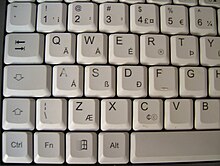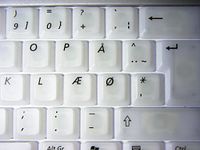Æ
| Æ | |
|---|---|
| Æ æ | |
 | |
| Usage | |
| Writing system | Latin script |
| Type | Typographic ligature |
| Language of origin | Latin language |
| Sound values | [æ, a, ɐ, i, ɛ, e] |
| History | |
| Development | |
| Sisters | Ӕ |
| Other | |
| Writing direction | Left-to-Right |


Æ (lowercase: æ) is a character formed from the letters a and e, originally a ligature representing the Latin diphthong ae. It has been promoted to the status of a letter in some languages, including Danish, Norwegian, Icelandic, and Faroese. It was also used in Old Swedish before being changed to ä. It was also used in Ossetian before switched back to its Cyrillic counterpart. The modern International Phonetic Alphabet uses it to represent the near-open front unrounded vowel (the sound represented by the 'a' in English words like cat). Diacritic variants include Ǣ/ǣ, Ǽ/ǽ, Æ̀/æ̀, Æ̂/æ̂ and Æ̃/æ̃.[a]
As a letter of the Old English Latin alphabet, it was called æsc, "ash tree",[1] after the Anglo-Saxon futhorc rune ᚫ which it transliterated; its traditional name in English is still ash, or æsh (Old English: æsċ) if the ligature is included.


Languages
[edit]Cyrillic
[edit]The Cyrillic Ӕ and ӕ are used in Ossetian.
English
[edit]
In English, use of the ligature varies between different places and contexts, but it is fairly rare. In modern typography, if technological limitations make the use of æ difficult (such as in use of typewriters, telegraphs, or ASCII), the digraph ae is often used instead.
In Old English, æ represented a sound between a and e (/æ/), very much like the short a of cat in many dialects of Modern English. If long vowels are distinguished from short vowels, the long version /æː/ is marked with a macron (ǣ) or, less commonly, an acute (ǽ).
In the United States, the issue of the ligature is sidestepped in many cases by use of a simplified spelling with "e", as happened with œ as well. Usage, however, may vary; for example, while medieval is now more common than mediaeval (and the now old-fashioned mediæval) even in the United Kingdom,[2] archeology is more commonly used over archaeology solely in the US.[3]
French
[edit]In the modern French alphabet, æ (called e-dans-l'a, 'e in the a') is used to spell Latin and Greek borrowings like curriculum vitæ, et cætera, ex æquo, tænia, and the first name Lætitia.[4] It is mentioned in the name of Serge Gainsbourg's song Elaeudanla Téïtéïa, a reading of the French spelling of the name Lætitia: "L, A, E dans l'A, T, I, T, I, A."[5]
Latin
[edit]In Classical Latin, the combination AE denotes the diphthong [ae̯], which had a value similar to the long i in fine as pronounced in most dialects of Modern English.[6] Both classical and present practice is to write the letters separately, but the ligature was used in medieval and early modern writings, in part because æ was reduced to the simple vowel [ɛ] during the Roman Empire. In some medieval scripts, the ligature was simplified to ę, an e with ogonek, called the e caudata (Latin for "tailed e"). That was further simplified into a plain e, which may have influenced or been influenced by the pronunciation change. However, the ligature is still relatively common in liturgical books and musical scores.
Other Germanic languages
[edit]Old Norse
In Old Norse, æ represents the long vowel /ɛː/. The short version of the same vowel, /ɛ/, if it is distinguished from /e/, is written as ę.
Icelandic
In Icelandic, æ represents the diphthong [ai], which can be long or short.
Faroese
In most varieties of Faroese, æ is pronounced as follows:
- [ɛa] when simultaneously stressed and occurring either word-finally, before a vowel letter, before a single consonant letter, or before the consonant-letter groups kl, kr, pl, pr, tr, kj, tj, sj, and those consisting of ð and one other consonant letter, except for ðr when pronounced like gr (except as below)
- a rather open [eː] when directly followed by the sound [a], as in ræðast (silent ð) and frægari (silent g)
- [a] in all other cases
One of its etymological origins is Old Norse é (the other is Old Norse æ), which is particularly evident in the dialects of Suðuroy, where Æ is [eː] or [ɛ]:
- æða (eider): Southern [eːa], Northern Faroese [ɛava]
- ætt (family, direction): Southern [ɛtː], Northern Faroese [atː]
German and Swedish
The equivalent letter in German and Swedish is ä, but it is not located at the same place within the alphabet. In German, it is not a separate letter from "A" but in Swedish, it is the second-to-last letter (between å and ö).
In the normalized spelling of Middle High German, æ represents a long vowel [ɛː]. The actual spelling in the manuscripts varies, however.
Danish and Norwegian

In Danish and Norwegian, æ is a separate letter of the alphabet that represents a monophthong. It follows z and precedes ø and å. In Norwegian, there are four ways of pronouncing the letter:
- /æː/ as in æ (the name of the letter), bær, Solskjær, læring, æra, Ænes, ærlig, tærne, Kværner, Dæhlie, særs, ærfugl, lært, trær ("trees")
- /æ/ as in færre, æsj, nærmere, Færder, Skjærvø, ærverdig, vært, lærd, Bræin (where æi is pronounced as a diphthong /æi/)
- /eː/ as in Sæther, Næser, Sæbø, gælisk, spælsau, bevæpne, sæd, æser, Cæsar, væte, trær ("thread(s)" [verb])
- /e/ as in Sæth, Næss, Brænne, Bækkelund, Vollebæk, væske, trædd
In many northern, western, and southwestern Norwegian dialects such as Trøndersk and in the western Danish dialects of Thy and Southern Jutland, the word "I" (Standard Danish: jeg, Bokmål Norwegian: jeg, Nynorsk Norwegian: eg) is pronounced /æː/.[7] Thus, when this word is written as it is pronounced in these dialects (rather than the standard), it is often spelled with the letter "æ".
In western and southern Jutish dialects of Danish, æ is also the proclitic definite article: æ hus (the house), as opposed to Standard Danish and all other Nordic varieties which have enclitic definite articles (Danish, Swedish, Norwegian: huset; Icelandic, Faroese: húsið [the house]).
Ossetian
[edit]
Ossetian used the letter æ when it was written using the Latin script from 1923 to 1938. Since then, Ossetian has used a Cyrillic alphabet with an identical-looking letter (Ӕ and ӕ). It is pronounced as a near-open central vowel ⟨ɐ⟩.
South American languages
[edit]The letter Æ is used in the official orthography of Kawésqar spoken in Chile and also in that of the Fuegian language Yaghan.
International Phonetic Alphabet
[edit]The symbol [æ] is also used in the International Phonetic Alphabet (IPA) to denote a near-open front unrounded vowel like in the word cat in many dialects of Modern English, which is the sound that was most likely represented by the Old English letter. In the IPA, it is always in lowercase. U+10783 𐞃 MODIFIER LETTER SMALL AE is a superscript IPA letter.[8]
Uralic Phonetic Alphabet
The Uralic Phonetic Alphabet (UPA) uses four additional æ-related symbols, see Unicode table below.[9]
Typing the character
[edit]

- The HTML entities are
Æandæ - Windows: Alt+0198 or Alt+146 for uppercase, Alt+0230 or Alt+145 for lowercase.[clarification needed]
- In the TeX typesetting system, ӕ is produced by
\ae. - Microsoft Word: Ctrl+⇧ Shift+& followed by A or a.
- X: Composeae and ComposeAE can be used.
- In all versions of the Mac OS (Systems 1 through 7, Mac OS 8 and 9, OS X, macOS 11, 12, 13, and the current macOS 14): æ: ⌥ Option+' (apostrophe key), Æ: ⌥ Option+⇧ Shift+'.
- On the iPhone, iPod touch and iPad, as well as phones running Google's Android OS or Windows Mobile OS and on the Kindle Touch and Paperwhite: hold down "A" until a small menu is displayed.
- On US-International keyboards, Æ is accessible with AltGr+z (X sometimes uses AltGr+a).
- The Icelandic keyboard layout has a separate key for Æ (and Ð, Þ and Ö).
- The Norwegian keyboard layout also has a separate key for Æ, rightmost of the letters, to the right of Ø and below Å.
- In Vim the digraph is 'AE' for Æ and 'ae' for æ. (Press Ctrl-K in Insert mode.)
Unicode
[edit]- U+00C6 Æ LATIN CAPITAL LETTER AE
- U+00E6 æ LATIN SMALL LETTER AE
- U+01E2 Ǣ LATIN CAPITAL LETTER AE WITH MACRON
- U+01E3 ǣ LATIN SMALL LETTER AE WITH MACRON
- U+01FC Ǽ LATIN CAPITAL LETTER AE WITH ACUTE
- U+01FD ǽ LATIN SMALL LETTER AE WITH ACUTE
- U+1D01 ᴁ LATIN LETTER SMALL CAPITAL AE (UPA)
- U+1D02 ᴂ LATIN SMALL LETTER TURNED AE (UPA)
- U+1D2D ᴭ MODIFIER LETTER CAPITAL AE (UPA)
- U+1D46 ᵆ MODIFIER LETTER SMALL TURNED AE (UPA)
- U+1DD4 ◌ᷔ COMBINING LATIN SMALL LETTER AE
- U+10783 𐞃 MODIFIER LETTER SMALL AE (IPA)
See also
[edit]- AE (Cyrillic)
- Ae (digraph)
- Å
- Ä
- Ę
- Ø
- Ö
- Œ
- Near-open front unrounded vowel (represented by æ in the IPA)
- Ə
- Ansuz rune
- List of English words that may be spelled with a ligature
- Anavae
- Aespa
Footnotes
[edit]Notes
[edit]- ^ More information may be found at their entries on Wiktionary (
 ǣ,
ǣ,  ᴂ, etc.), and on the appendix page there entitled
ᴂ, etc.), and on the appendix page there entitled  Variations of ae.
Variations of ae.
References
[edit]- ^ Harrison, James A.; Baskervill, W. M., eds. (1885). "æsc". A Handy Anglo-Saxon Dictionary: Based on Groschopp's Grein. A. S. Barnes. p. 11.
- ^ The spelling medieval is given priority in both Oxford and Cambridge Advanced Learner's Dictionary. Accessed June 2nd, 2024.
- ^ Merriam-Webster Advanced Learner's Dictionary. Accessed June 2nd, 2024.
- ^ "La ligature æ". monsu.desiderio.free.fr. Retrieved 2024-08-16.
- ^ Serge Gainsbourg "Elaeudanla teïtéïa" | INA (in French). Retrieved 2024-08-16 – via www.ina.fr.
- ^ James Morwood (1999). Latin Grammar, Oxford University Press. ISBN 978-0-19-860199-9, p. 3
- ^ Albert, Daniel (2022-06-24). "Trøndersk: The Dialects of Middle Norway". Life in Norway. Retrieved 2023-10-18.
- ^ Miller, Kirk; Ashby, Michael (2020-11-08). "L2/20-252R: Unicode request for IPA modifier-letters (a), pulmonic" (PDF).
- ^ Everson, Michael; et al. (2002-03-20). "L2/02-141: Uralic Phonetic Alphabet characters for the UCS" (PDF).
Further reading
[edit]- Robert Bringhurst (2002). The Elements of Typographic Style. Vancouver: Hartley & Marks. ISBN 0-88179-205-5. p. 271.
External links
[edit] The dictionary definition of Æ at Wiktionary
The dictionary definition of Æ at Wiktionary The dictionary definition of Category:English terms spelled with Æ at Wiktionary
The dictionary definition of Category:English terms spelled with Æ at Wiktionary Media related to Æ at Wikimedia Commons
Media related to Æ at Wikimedia Commons

